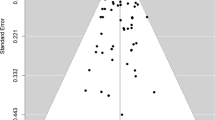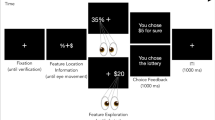Abstract
This article provides a theoretical account and identifies boundary conditions for the common beliefs about the “overweighting of small probabilities”. Based on four studies, our results suggest that the weighting of probabilities is context-dependent. When the contrast in value is reduced or not presented in a decision problem, small probabilities are less likely to be overweighted. In addition, as the associated payoffs increase, the weights on small probabilities tend to diminish or even to be “underweighted”. However, there is an “interpersonal difference” in the weighting of probabilities which reflects the particular circumstances of individuals, including their wealth status. Some implications of small probabilities for marketing practices are also investigated and discussed.
Similar content being viewed by others
References
Abdellaoui, Mohammed. (2000). “Parameter-Free Elicitation of Utility and Probability Weighting Functions,” Management Science 46(Nov.), 1497–1512.
Bleichrodt, Han and Jose Luis Pinto. (2000). “A Parameter–Free Elicitation of the Probability Weighting Function in Medical Decision Analysis,” Management Science 46(Nov.), 1485–1496.
Choong, Peggy. (2001). “Preventing or Fixing a Problem: a Marketing Manager’s Dilemma Revisited,” The Journal of Services Marketing, 15(2), 99–112.
Donovan, Robert J. and Geoffrey Jalleh. (1999). “Positively versus Negatively Framed Product Attributes: The Influence of Involvement,” Psychology & Marketing 16(Oct.), 613–630.
Feldman, J. M. and J. G. Lynch, Jr. (1988). “Self-Generated Validity and Other Effects of Measurement on Belief, Attitude, Intention, and Behavior,” Journal of Applied Psychology 73(Aug.), 421–435.
Fischer, Gregory W., Ziv Carmon, Dan Ariely, and Gal Zauberman. (1999). “Goal-based Construction of Preferences: Task Goals and the Prominence Effect,” Management Science 45(Aug.), 1057–1075.
Gonzalez, Richard and George Wu. (1999). “On the Shape of the Probability Weighting Function,” Cognitive Psychology 38(Feb.), 129–166.
Hogarth, R. M. and H. J. Einhorn. (1990). “Venture Theory: A Model of Decision Weights,” Management Science 36(July), 780–803.
Hsee, Christopher K., Sally Blount, George F. Loewenstein, and Maz H. Maz. (1999). “Preference Reversals between Joint and Separate Evaluations of Options: A Review and Theoretical Analysis,” Psychological Bulletin 125(Sept.), 576–590.
Janiszewski, Chris and Luk Warlop. (1993). “The Influence of Classical Conditioning Procedures on Subsequent Attention to the Conditioned Brand,” Journal of Consumer Research 20(Sept.), 171–189.
Kahneman, Daniel and Amos Tversky. (1979). “Prospect Theory: An Analysis of Decision under Risk,” Econometrica 47(March), 263–291.
Kahneman, Daniel and Amos Tversky. (1984). “Choices, Values, and Frames,” American Psychologist 39(4), 341–350.
Kahneman, Daniel, J. L. Knetsch, and R. H. Thaler. (1991). “The Endowment Effect, Loss Aversion and Status Quo Bias,” Journal of Economic Perspectives 17(Winter), 193–206.
Kilka, M. and M. Weber. (2001). “What Determines the Shape of the Probability Weighting Function under Uncertainty?” Management Science 47(Dec.), 1712–1726.
Kirby, Kris N. and Mariana Santiesteban. (2003). “Concave Utility, Transaction Costs, and Risk in Measuring Discounting of Delayed Rewards,” Journal of Experimental Psychology 29(Jan.), 66–79.
Levin, Irwin P., Judy Schreiber, Marco Lauriola, and Gary J. Gaeth. (2002). “A Tale of Two Pizzas: Building Up from a Basic Product Versus Scaling Down from a Fully-Loaded Product,” Marketing Letters 13(Nov.), 335–344.
Lynch, J. G., Jr., H. Marmorstein, and M. F. Weigold. (1988). “Choices from Sets Including Remembered Brands: Use of Recalled Attributes and Prior Overall Evaluations,” Journal of Consumer Research 15(Sept.), 169–184.
Mazumdar, Tridib and Purushottam Papatla. (2000). “An Investigation of Reference Price Segments,” Journal of Marketing Research 37(May), 246–258.
McCool, Steven F. (1991). “Using Probabilistic Incentives to Increase Response Rates to Mail-Return Highway Intercept Diaries,” Journal of Travel Research 30(Fall), 17–19.
Nowlis, Stephen M. and Itamar Simonson. (1997). “Attribute-Task Compatibility as Determinant of Consumer Preference Reversals,” Journal of Marketing Research 34(May), 205–218.
Prelec, D. (1998). “The Probability Weighting Function,” Econometrica 66(May), 497–527.
Preston, M. and P. Baratta. (1948). “An Experimental Study of the Auction-Value of an Uncertain Outcome,” American Journal of Psychology 61, 183–193.
Rajendran, K. N. and Gerard J. Tellis (1994), “Contextual and Temporal Components of Reference Price,” Journal of Marketing 58(Jan.), 22–34.
Richardson, Paul S., Alan S. Dick, and Arun K. Jain. (1994). “Extrinsic and Intrinsic Cue Effects on Perceptions of Store Brand Quality,” Journal of Marketing 58(Oct.), 28–36.
Rottenstreich, Yuval and Christopher K. Hsee. (2001). “Money, Kisses, and Electric Shocks: On the Affective Psychology of Risk,” Psychological Science 12(May), 185–190.
Samuelson, William and Richard Zeckhauser. (1988). “Status Quo Bias in Decision Making,” Journal of Risk and Uncertainty 1(March), 7–59.
Schkade, David A. and Eric J. Johnson. (1989). “Cognitive Processes in Preference Reversals,” Organizational Behavior and Human Decision Processes 44(Oct.), 203–231.
Thaler, Richard. (1985). “Mental Accounting and Consumer Choice,” Marketing Science 4(Summer), 199–214.
Tversky, Amos and Daniel Kahneman. (1991). “Loss Aversion in Riskless Choice: A Reference-Dependent Model,” The Quarterly Journal of Economics 106(Nov.), 1039–1061.
Tversky, Amos and Daniel Kahneman. (1992). “Advanced in Prospect Theory: Cumulative Representations of Uncertainty,” Journal of Risk and Uncertainty 5, 297–323.
Tversky, Amos, S. Sattath, and P. Slovic. (1988). “Contingent Weighting in Judgment and Choice,” Psychological Review 95(3), 371–384.
Wu, George and R. Gonzalez. (1999). “Nonlinear Decision Weights in Choice under Uncertainty,” Management Science 45(Jan.), 74–85.
Wu, George. (1999). “Anxiety and Decision Making with Delayed Resolution of Uncertainty,” Theory and Decision 46(April), 159–198.
Author information
Authors and Affiliations
Corresponding author
Rights and permissions
About this article
Cite this article
Chen, R., Jia, J. Consumer Choices Under Small Probabilities: Overweighting or Underweighting?. Market Lett 16, 5–18 (2005). https://doi.org/10.1007/s11002-005-1137-7
Issue Date:
DOI: https://doi.org/10.1007/s11002-005-1137-7




